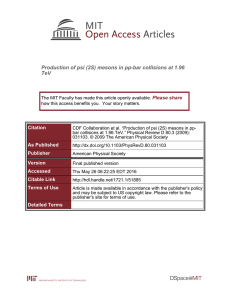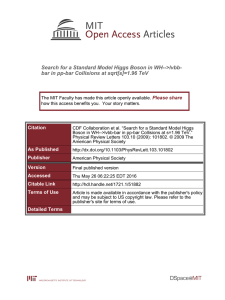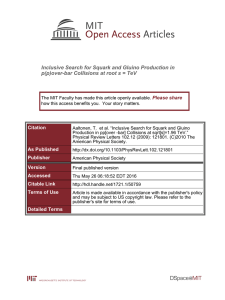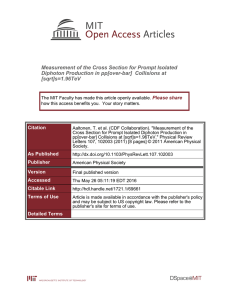Search for the Decays B(s)-->e+mu- and B(s)-->e+e- in CDF Run II
advertisement
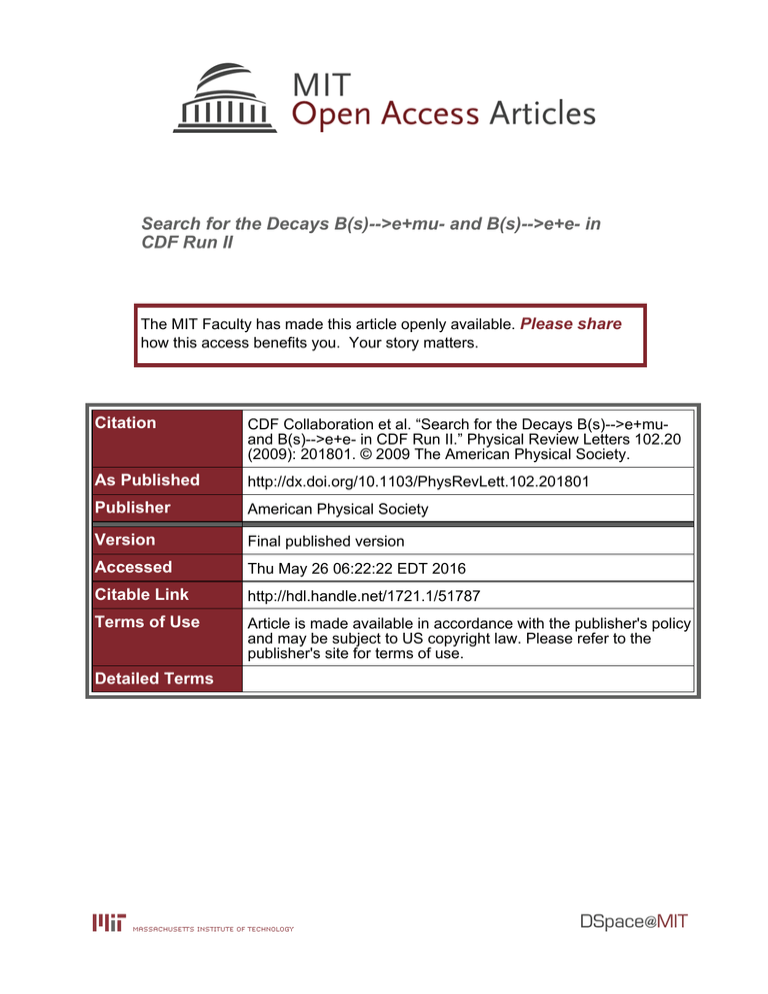
Search for the Decays B(s)-->e+mu- and B(s)-->e+e- in CDF Run II The MIT Faculty has made this article openly available. Please share how this access benefits you. Your story matters. Citation CDF Collaboration et al. “Search for the Decays B(s)-->e+muand B(s)-->e+e- in CDF Run II.” Physical Review Letters 102.20 (2009): 201801. © 2009 The American Physical Society. As Published http://dx.doi.org/10.1103/PhysRevLett.102.201801 Publisher American Physical Society Version Final published version Accessed Thu May 26 06:22:22 EDT 2016 Citable Link http://hdl.handle.net/1721.1/51787 Terms of Use Article is made available in accordance with the publisher's policy and may be subject to US copyright law. Please refer to the publisher's site for terms of use. Detailed Terms PRL 102, 201801 (2009) PHYSICAL REVIEW LETTERS week ending 22 MAY 2009 Search for the Decays B0ðsÞ ! eþ and B0ðsÞ ! eþ e in CDF Run II T. Aaltonen,24 J. Adelman,14 T. Akimoto,56 B. Álvarez González,12,t S. Amerio,44b,44a D. Amidei,35 A. Anastassov,39 A. Annovi,20 J. Antos,15 G. Apollinari,18 A. Apresyan,49 T. Arisawa,58 A. Artikov,16 W. Ashmanskas,18 A. Attal,4 A. Aurisano,54 F. Azfar,43 P. Azzurri,47b,47a W. Badgett,18 A. Barbaro-Galtieri,29 V. E. Barnes,49 B. A. Barnett,26 V. Bartsch,31 G. Bauer,33 P.-H. Beauchemin,34 F. Bedeschi,47a D. Beecher,31 S. Behari,26 G. Bellettini,47b,47a J. Bellinger,60 D. Benjamin,17 A. Beretvas,18 J. Beringer,29 A. Bhatti,51 M. Binkley,18 D. Bisello,44b,44a I. Bizjak,31,y R. E. Blair,2 C. Blocker,7 B. Blumenfeld,26 A. Bocci,17 A. Bodek,50 V. Boisvert,50 G. Bolla,49 D. Bortoletto,49 J. Boudreau,48 A. Boveia,11 B. Brau,11,b A. Bridgeman,25 L. Brigliadori,44a C. Bromberg,36 E. Brubaker,14 J. Budagov,16 H. S. Budd,50 S. Budd,25 S. Burke,18 K. Burkett,18 G. Busetto,44b,44a P. Bussey,22 A. Buzatu,34 K. L. Byrum,2 S. Cabrera,17,v C. Calancha,32 M. Campanelli,36 M. Campbell,35 F. Canelli,14,18 A. Canepa,46 B. Carls,25 D. Carlsmith,60 R. Carosi,47a S. Carrillo,19,o S. Carron,34 B. Casal,12 M. Casarsa,18 A. Castro,6b,6a P. Catastini,47c,47a D. Cauz,55b,55a V. Cavaliere,47c,47a M. Cavalli-Sforza,4 A. Cerri,29 L. Cerrito,31,p S. H. Chang,28 Y. C. Chen,1 M. Chertok,8 G. Chiarelli,47a G. Chlachidze,18 F. Chlebana,18 K. Cho,28 D. Chokheli,16 J. P. Chou,23 G. Choudalakis,33 S. H. Chuang,53 K. Chung,13 W. H. Chung,60 Y. S. Chung,50 T. Chwalek,27 C. I. Ciobanu,45 M. A. Ciocci,47c,47a A. Clark,21 D. Clark,7 G. Compostella,44a M. E. Convery,18 J. Conway,8 M. Cordelli,20 G. Cortiana,44b,44a C. A. Cox,8 D. J. Cox,8 F. Crescioli,47b,47a C. Cuenca Almenar,8,v J. Cuevas,12,t R. Culbertson,18 J. C. Cully,35 D. Dagenhart,18 M. Datta,18 T. Davies,22 P. de Barbaro,50 S. De Cecco,52a A. Deisher,29 G. De Lorenzo,4 M. Dell’Orso,47b,47a C. Deluca,4 L. Demortier,51 J. Deng,17 M. Deninno,6a P. F. Derwent,18 G. P. di Giovanni,45 C. Dionisi,52b,52a B. Di Ruzza,55b,55a J. R. Dittmann,5 M. D’Onofrio,4 S. Donati,47b,47a P. Dong,9 J. Donini,44a T. Dorigo,44a S. Dube,53 J. Efron,40 A. Elagin,54 R. Erbacher,8 D. Errede,25 S. Errede,25 R. Eusebi,18 H. C. Fang,29 S. Farrington,43 W. T. Fedorko,14 R. G. Feild,61 M. Feindt,27 J. P. Fernandez,32 C. Ferrazza,47d,47a R. Field,19 G. Flanagan,49 R. Forrest,8 M. J. Frank,5 M. Franklin,23 J. C. Freeman,18 I. Furic,19 M. Gallinaro,52a J. Galyardt,13 F. Garberson,11 J. E. Garcia,21 A. F. Garfinkel,49 K. Genser,18 H. Gerberich,25 D. Gerdes,35 A. Gessler,27 S. Giagu,52b,52a V. Giakoumopoulou,3 P. Giannetti,47a K. Gibson,48 J. L. Gimmell,50 C. M. Ginsburg,18 N. Giokaris,3 M. Giordani,55b,55a P. Giromini,20 M. Giunta,47b,47a G. Giurgiu,26 V. Glagolev,16 D. Glenzinski,18 M. Gold,38 N. Goldschmidt,19 A. Golossanov,18 G. Gomez,12 G. Gomez-Ceballos,33 M. Goncharov,33 O. González,32 I. Gorelov,38 A. T. Goshaw,17 K. Goulianos,51 A. Gresele,44b,44a S. Grinstein,23 C. Grosso-Pilcher,14 R. C. Group,18 U. Grundler,25 J. Guimaraes da Costa,23 Z. Gunay-Unalan,36 C. Haber,29 K. Hahn,33 S. R. Hahn,18 E. Halkiadakis,53 B.-Y. Han,50 J. Y. Han,50 F. Happacher,20 K. Hara,56 D. Hare,53 M. Hare,57 S. Harper,43 R. F. Harr,59 R. M. Harris,18 M. Hartz,48 K. Hatakeyama,51 C. Hays,43 M. Heck,27 A. Heijboer,46 J. Heinrich,46 C. Henderson,33 M. Herndon,60 J. Heuser,27 S. Hewamanage,5 D. Hidas,17 C. S. Hill,11,d D. Hirschbuehl,27 A. Hocker,18 S. Hou,1 M. Houlden,30 S.-C. Hsu,29 B. T. Huffman,43 R. E. Hughes,40 U. Husemann,61 M. Hussein,36 J. Huston,36 J. Incandela,11 G. Introzzi,47a M. Iori,52b,52a A. Ivanov,8 E. James,18 D. Jang,13 B. Jayatilaka,17 E. J. Jeon,28 M. K. Jha,6a S. Jindariani,18 W. Johnson,8 M. Jones,49 K. K. Joo,28 S. Y. Jun,13 J. E. Jung,28 T. R. Junk,18 T. Kamon,54 D. Kar,19 P. E. Karchin,59 Y. Kato,42,m R. Kephart,18 J. Keung,46 V. Khotilovich,54 B. Kilminster,18 D. H. Kim,28 H. S. Kim,28 H. W. Kim,28 J. E. Kim,28 M. J. Kim,20 S. B. Kim,28 S. H. Kim,56 Y. K. Kim,14 N. Kimura,56 L. Kirsch,7 S. Klimenko,19 B. Knuteson,33 B. R. Ko,17 K. Kondo,58 D. J. Kong,28 J. Konigsberg,19 A. Korytov,19 A. V. Kotwal,17 M. Kreps,27 J. Kroll,46 D. Krop,14 N. Krumnack,5 M. Kruse,17 V. Krutelyov,11 T. Kubo,56 T. Kuhr,27 N. P. Kulkarni,59 M. Kurata,56 S. Kwang,14 A. T. Laasanen,49 S. Lami,47a S. Lammel,18 M. Lancaster,31 R. L. Lander,8 K. Lannon,40,s A. Lath,53 G. Latino,47c,47a I. Lazzizzera,44b,44a T. LeCompte,2 E. Lee,54 H. S. Lee,14 S. W. Lee,54,u S. Leone,47a J. D. Lewis,18 C.-S. Lin,29 J. Linacre,43 M. Lindgren,18 E. Lipeles,46 A. Lister,8 D. O. Litvintsev,18 C. Liu,48 T. Liu,18 N. S. Lockyer,46 A. Loginov,61 M. Loreti,44b,44a L. Lovas,15 D. Lucchesi,44b,44a C. Luci,52b,52a J. Lueck,27 P. Lujan,29 P. Lukens,18 G. Lungu,51 L. Lyons,43 J. Lys,29 R. Lysak,15 D. MacQueen,34 R. Madrak,18 K. Maeshima,18 K. Makhoul,33 T. Maki,24 P. Maksimovic,26 S. Malde,43 S. Malik,31 G. Manca,30,f A. Manousakis-Katsikakis,3 F. Margaroli,49 C. Marino,27 C. P. Marino,25 A. Martin,61 V. Martin,22,l M. Martı́nez,4 R. Martı́nez-Balları́n,32 T. Maruyama,56 P. Mastrandrea,52a T. Masubuchi,56 M. Mathis,26 M. E. Mattson,59 P. Mazzanti,6a K. S. McFarland,50 P. McIntyre,54 R. McNulty,30,k A. Mehta,30 P. Mehtala,24 A. Menzione,47a P. Merkel,49 C. Mesropian,51 T. Miao,18 N. Miladinovic,7 R. Miller,36 C. Mills,23 M. Milnik,27 A. Mitra,1 G. Mitselmakher,19 H. Miyake,56 N. Moggi,6a C. S. Moon,28 R. Moore,18 M. J. Morello,47b,47a J. Morlock,27 P. Movilla Fernandez,18 J. Mülmenstädt,29 A. Mukherjee,18 Th. Muller,27 R. Mumford,26 P. Murat,18 M. Mussini,6b,6a J. Nachtman,18 Y. Nagai,56 A. Nagano,56 J. Naganoma,56 K. Nakamura,56 I. Nakano,41 A. Napier,57 V. Necula,17 J. Nett,60 C. Neu,46,w 0031-9007=09=102(20)=201801(8) 201801-1 Ó 2009 The American Physical Society PRL 102, 201801 (2009) PHYSICAL REVIEW LETTERS week ending 22 MAY 2009 M. S. Neubauer,25 S. Neubauer,27 J. Nielsen,29,h L. Nodulman,2 M. Norman,10 O. Norniella,25 E. Nurse,31 L. Oakes,43 S. H. Oh,17 Y. D. Oh,28 I. Oksuzian,19 T. Okusawa,42 R. Orava,24 K. Osterberg,24 S. Pagan Griso,44b,44a E. Palencia,18 V. Papadimitriou,18 A. Papaikonomou,27 A. A. Paramonov,14 B. Parks,40 S. Pashapour,34 J. Patrick,18 G. Pauletta,55b,55a M. Paulini,13 C. Paus,33 T. Peiffer,27 D. E. Pellett,8 A. Penzo,55a T. J. Phillips,17 G. Piacentino,47a E. Pianori,46 L. Pinera,19 K. Pitts,25 C. Plager,9 L. Pondrom,60 O. Poukhov,16,a N. Pounder,43 F. Prakoshyn,16 A. Pronko,18 J. Proudfoot,2 F. Ptohos,18,j E. Pueschel,13 G. Punzi,47b,47a J. Pursley,60 J. Rademacker,43,d A. Rahaman,48 V. Ramakrishnan,60 N. Ranjan,49 I. Redondo,32 P. Renton,43 M. Renz,27 M. Rescigno,52a S. Richter,27 F. Rimondi,6b,6a L. Ristori,47a A. Robson,22 T. Rodrigo,12 T. Rodriguez,46 E. Rogers,25 S. Rolli,57 R. Roser,18 M. Rossi,55a R. Rossin,11 P. Roy,34 A. Ruiz,12 J. Russ,13 V. Rusu,18 B. Rutherford,18 H. Saarikko,24 A. Safonov,54 W. K. Sakumoto,50 O. Saltó,4 L. Santi,55b,55a S. Sarkar,52b,52a L. Sartori,47a K. Sato,18 A. Savoy-Navarro,45 P. Schlabach,18 A. Schmidt,27 E. E. Schmidt,18 M. A. Schmidt,14 M. P. Schmidt,61,a M. Schmitt,39 T. Schwarz,8 L. Scodellaro,12 A. Scribano,47c,47a F. Scuri,47a A. Sedov,49 S. Seidel,38 Y. Seiya,42 A. Semenov,16 L. Sexton-Kennedy,18 F. Sforza,47a A. Sfyrla,25 S. Z. Shalhout,59 T. Shears,30 P. F. Shepard,48 M. Shimojima,56,r S. Shiraishi,14 M. Shochet,14 Y. Shon,60 I. Shreyber,37 A. Sidoti,47a P. Sinervo,34 A. Sisakyan,16 A. J. Slaughter,18 J. Slaunwhite,40 K. Sliwa,57 J. R. Smith,8 F. D. Snider,18 R. Snihur,34 A. Soha,8 S. Somalwar,53 V. Sorin,36 J. Spalding,18 T. Spreitzer,34 P. Squillacioti,47c,47a M. Stanitzki,61 R. St. Denis,22 B. Stelzer,34 O. Stelzer-Chilton,34 D. Stentz,39 J. Strologas,38 G. L. Strycker,35 D. Stuart,11 J. S. Suh,28 A. Sukhanov,19 I. Suslov,16 T. Suzuki,56 A. Taffard,25,g R. Takashima,41 Y. Takeuchi,56 R. Tanaka,41 M. Tecchio,35 P. K. Teng,1 K. Terashi,51 J. Thom,18,i A. S. Thompson,22 G. A. Thompson,25 E. Thomson,46 P. Tipton,61 P. Ttito-Guzmán,32 S. Tkaczyk,18 D. Toback,54 S. Tokar,15 K. Tollefson,36 T. Tomura,56 D. Tonelli,18 S. Torre,20 D. Torretta,18 P. Totaro,55b,55a S. Tourneur,45 M. Trovato,47a S.-Y. Tsai,1 Y. Tu,46 N. Turini,47c,47a F. Ukegawa,56 S. Vallecorsa,21 N. van Remortel,24,c A. Varganov,35 E. Vataga,47d,47a F. Vázquez,19,o G. Velev,18 C. Vellidis,3 M. Vidal,32 R. Vidal,18 I. Vila,12 R. Vilar,12 T. Vine,31 M. Vogel,38 I. Volobouev,29,u G. Volpi,47b,47a P. Wagner,46 R. G. Wagner,2 R. L. Wagner,18 W. Wagner,27,x J. Wagner-Kuhr,27 T. Wakisaka,42 R. Wallny,9 S. M. Wang,1 A. Warburton,34 D. Waters,31 M. Weinberger,54 J. Weinelt,27 H. Wenzel,18 W. C. Wester III,18 B. Whitehouse,57 D. Whiteson,46,g A. B. Wicklund,2 E. Wicklund,18 S. Wilbur,14 G. Williams,34 H. H. Williams,46 P. Wilson,18 B. L. Winer,40 P. Wittich,18,i S. Wolbers,18 C. Wolfe,14 T. Wright,35 X. Wu,21 F. Würthwein,10 S. Xie,33 A. Yagil,10 K. Yamamoto,42 J. Yamaoka,17 U. K. Yang,14,q Y. C. Yang,28 W. M. Yao,29 G. P. Yeh,18 J. Yoh,18 K. Yorita,58 T. Yoshida,42,n G. B. Yu,50 I. Yu,28 S. S. Yu,18 J. C. Yun,18 L. Zanello,52b,52a A. Zanetti,55a X. Zhang,25 Y. Zheng,9,e and S. Zucchelli6b,6a (CDF Collaboration) 1 Institute of Physics, Academia Sinica, Taipei, Taiwan 11529, Republic of China 2 Argonne National Laboratory, Argonne, Illinois 60439, USA 3 University of Athens, 157 71 Athens, Greece 4 Institut de Fisica d’Altes Energies, Universitat Autonoma de Barcelona, E-08193, Bellaterra (Barcelona), Spain 5 Baylor University, Waco, Texas 76798, USA 6a Istituto Nazionale di Fisica Nucleare Bologna, I-40127 Bologna, Italy 6b University of Bologna, I-40127 Bologna, Italy 7 Brandeis University, Waltham, Massachusetts 02254, USA 8 University of California, Davis, Davis, California 95616, USA 9 University of California, Los Angeles, Los Angeles, California 90024, USA 10 University of California, San Diego, La Jolla, California 92093, USA 11 University of California, Santa Barbara, Santa Barbara, California 93106, USA 12 Instituto de Fisica de Cantabria, CSIC-University of Cantabria, 39005 Santander, Spain 13 Carnegie Mellon University, Pittsburgh, Pennsylvania 15213, USA 14 Enrico Fermi Institute, University of Chicago, Chicago, Illinois 60637, USA 15 Comenius University, 842 48 Bratislava, Slovakia; Institute of Experimental Physics, 040 01 Kosice, Slovakia 16 Joint Institute for Nuclear Research, RU-141980 Dubna, Russia 17 Duke University, Durham, North Carolina 27708, USA 18 Fermi National Accelerator Laboratory, Batavia, Illinois 60510, USA 19 University of Florida, Gainesville, Florida 32611, USA 20 Laboratori Nazionali di Frascati, Istituto Nazionale di Fisica Nucleare, I-00044 Frascati, Italy 21 University of Geneva, CH-1211 Geneva 4, Switzerland 22 Glasgow University, Glasgow G12 8QQ, United Kingdom 201801-2 PHYSICAL REVIEW LETTERS PRL 102, 201801 (2009) 23 week ending 22 MAY 2009 Harvard University, Cambridge, Massachusetts 02138, USA Division of High Energy Physics, Department of Physics, University of Helsinki and Helsinki Institute of Physics, FIN-00014, Helsinki, Finland 25 University of Illinois, Urbana, Illinois 61801, USA 26 The Johns Hopkins University, Baltimore, Maryland 21218, USA 27 Institut für Experimentelle Kernphysik, Universität Karlsruhe, 76128 Karlsruhe, Germany 28 Center for High Energy Physics: Kyungpook National University, Daegu 702-701, Korea; Seoul National University, Seoul 151-742, Korea; Sungkyunkwan University, Suwon 440-746, Korea; Korea Institute of Science and Technology Information, Daejeon, 305-806, Korea; Chonnam National University, Gwangju, 500-757, Korea 29 Ernest Orlando Lawrence Berkeley National Laboratory, Berkeley, California 94720, USA 30 University of Liverpool, Liverpool L69 7ZE, United Kingdom 31 University College London, London WC1E 6BT, United Kingdom 32 Centro de Investigaciones Energeticas Medioambientales y Tecnologicas, E-28040 Madrid, Spain 33 Massachusetts Institute of Technology, Cambridge, Massachusetts 02139, USA 34 Institute of Particle Physics: McGill University, Montréal, Québec, Canada H3A 2T8; Simon Fraser University, Burnaby, British Columbia, Canada V5A 1S6; University of Toronto, Toronto, Ontario, Canada M5S 1A7; and TRIUMF, Vancouver, British Columbia, Canada V6T 2A3 35 University of Michigan, Ann Arbor, Michigan 48109, USA 36 Michigan State University, East Lansing, Michigan 48824, USA 37 Institution for Theoretical and Experimental Physics, ITEP, Moscow 117259, Russia 38 University of New Mexico, Albuquerque, New Mexico 87131, USA 39 Northwestern University, Evanston, Illinois 60208, USA 40 The Ohio State University, Columbus, Ohio 43210, USA 41 Okayama University, Okayama 700-8530, Japan 42 Osaka City University, Osaka 588, Japan 43 University of Oxford, Oxford OX1 3RH, United Kingdom 44a Istituto Nazionale di Fisica Nucleare, Sezione di Padova-Trento, I-35131 Padova, Italy 44b University of Padova, I-35131 Padova, Italy 45 LPNHE, Universite Pierre et Marie Curie/IN2P3-CNRS, UMR7585, Paris, F-75252 France 46 University of Pennsylvania, Philadelphia, Pennsylvania 19104, USA 47a Istituto Nazionale di Fisica Nucleare Pisa, I-56127 Pisa, Italy 47b University of Pisa, I-56127 Pisa, Italy 47c University of Siena, I-56127 Pisa, Italy 47d Scuola Normale Superiore, I-56127 Pisa, Italy 48 University of Pittsburgh, Pittsburgh, Pennsylvania 15260, USA 49 Purdue University, West Lafayette, Indiana 47907, USA 50 University of Rochester, Rochester, New York 14627, USA 51 The Rockefeller University, New York, New York 10021, USA 52a Istituto Nazionale di Fisica Nucleare, Sezione di Roma 1, I-00185 Roma, Italy 52b Sapienza Università di Roma, I-00185 Roma, Italy 53 Rutgers University, Piscataway, New Jersey 08855, USA 54 Texas A&M University, College Station, Texas 77843, USA 55a Istituto Nazionale di Fisica Nucleare Trieste/Udine, I-34100 Trieste, Italy 55b University of Trieste/Udine, I-33100 Udine, Italy 56 University of Tsukuba, Tsukuba, Ibaraki 305, Japan 57 Tufts University, Medford, Massachusetts 02155, USA 58 Waseda University, Tokyo 169, Japan 59 Wayne State University, Detroit, Michigan 48201, USA 60 University of Wisconsin, Madison, Wisconsin 53706, USA 61 Yale University, New Haven, Connecticut 06520, USA (Received 23 January 2009; published 21 May 2009) 24 We report results from a search for the lepton flavor violating decays B0s ! eþ and B0 ! eþ , and the flavor-changing neutral-current decays B0s ! eþ e and B0 ! eþ e . The analysis uses data pffiffiffi corresponding to 2 fb1 of integrated luminosity of pp collisions at s ¼ 1:96 TeV collected with the upgraded Collider Detector (CDF II) at the Fermilab Tevatron. The observed number of B0 and B0s candidates is consistent with background expectations. The resulting Bayesian upper limits on the branching ratios at 90% credibility level are BðB0s ! eþ Þ < 2:0 107 , BðB0 ! eþ Þ < 6:4 108 , 201801-3 PRL 102, 201801 (2009) PHYSICAL REVIEW LETTERS week ending 22 MAY 2009 BðB0s ! eþ e Þ < 2:8 107 , and BðB0 ! eþ e Þ < 8:3 108 . From the limits on BðB0ðsÞ ! eþ Þ, the following lower bounds on the Pati-Salam leptoquark masses are also derived: MLQ ðB0s ! eþ Þ > 47:8 TeV=c2 , and MLQ ðB0 ! eþ Þ > 59:3 TeV=c2 , at 90% credibility level. DOI: 10.1103/PhysRevLett.102.201801 PACS numbers: 13.20.He, 11.30.Hv, 12.15.Mm, 12.60.i Rare particle decays that are either forbidden within the standard model (SM) of particle physics or are expected to have very small branching ratios provide excellent signatures with which to look for new physics and allow us to probe subatomic processes that are beyond the reach of direct searches. The decays B0s ! eþ and B0 ! eþ [1] are forbidden within the SM, in which lepton number and lepton flavor are conserved. However, the observation of neutrino oscillations indicates that lepton flavor is not conserved. To date, no lepton flavor violating (LFV) decays in the charged sector such as B0s ! eþ and B0 ! eþ have been observed. These decays are allowed in models where the SM has been extended by heavy singlet Dirac neutrinos [2]. The LFV decays are also allowed in some physics scenarios beyond the SM, such as the PatiSalam model [3] and supersymmetry models [4]. The grand-unification theory by Pati and Salam predicts a new interaction to mediate transitions between leptons and quarks via exchange of spin-1 gauge bosons, which are called Pati-Salam leptoquarks (LQ), that carry both color and lepton quantum numbers [3]. The lepton and quark components of the leptoquarks are not necessarily from the same generation [5,6], and the decays B0s ! eþ and B0 ! eþ can be mediated by different types of leptoquarks. Processes involving flavor-changing neutral currents (FCNCs) can occur in the SM only through higher-order Feynman diagrams where new physics contributions can provide a significant enhancement. Compared to B0ðsÞ ! þ [7], the FCNC decays of B0ðsÞ ! eþ e are further suppressed by the square of the ratio of the electron and muon masses ðme =m Þ2 . The SM expectations for branching ratios of B0ðsÞ ! eþ e are of the order of 1015 [8]. In this Letter we report on a search for the LFV decays B0s ! eþ and B0 ! eþ and the FCNC decays B0ðsÞ ! eþ e , using a data sample corresponding to 1 2 fb pffiffiffi of integrated luminosity collected in pp collisions at s ¼ 1:96 TeV. With no evidence for either the LFV or FCNC decays, we set upper limits on their branching ratios using the common reference decay B0 ! Kþ , which has a precisely known branching ratio. A detailed description of the CDF II detector can be found in Ref. [9]. Here we give a brief description of the detector elements most relevant to this analysis. Charged particle tracking is provided by a silicon microstrip detector together with the surrounding open-cell wire drift chamber (COT), both immersed in a 1.4 T axial magnetic field. The tracking system provides precise vertex and momentum measurement for charged particles in the pseu- dorapidity range jj < 1:0 [10]. Surrounding the tracking system are electromagnetic (CEM) and hadronic sampling calorimeters, arranged in a projective geometry. Drift chambers and scintillation counters are located behind the calorimeters to detect muons within jj < 0:6 (CMU) and 0:6 < jj < 1:0 (CMX). We use a data sample enriched in two-body B decays selected by a three-level trigger system using the extremely fast tracker [11] at level 1, and the silicon vertex trigger [12] at level 2. The trigger requires two oppositely charged tracks, each with a transverse momentum pT > 2 GeV=c, and an impact parameter [13] 0:1 < d0 < 1 mm. It also requires the scalar sum of the transverse momenta of the two tracks to be greater than 5:5 GeV=c, the difference in the azimuthal angles of the tracks 20 < ’ < 135 , and a transverse decay length [14] Lxy > 200 m. At the level-3 trigger stage, and in the off-line analysis, the trigger selections are enforced with a more accurate determination of the same quantities. In the off-line analysis, additionally we require the B-meson isolation I > 0:675 [15], the pointing angle < 6:3 [16], and a tighter selection of Lxy > 375 m. These three thresholds were optimized in an unbiased way to obtain the best sensitivity for the searches using the procedure described in Ref. [17]. Electron and muon identification is applied in the selection of B0s ðB0 Þ ! eþ and B0s ðB0 Þ ! eþ e decay modes. The electron identification [18] requires that both the specific ionization (dE=dx) measured in the COT and the transverse and longitudinal shower shape as measured in the CEM be consistent with the hypothesis that the particle is an electron. The performance of electron identification is optimized using pure electron samples reconstructed from ! eþ e conversions and hadron and muon samples from D0 ! K þ , ! p , and J= c ! þ decays. We find the identification efficiency to be around 70% for electrons passing through the fiducial regions of the detectors used for electron identification. The muon identification starts from tracks in the COT that are extrapolated into the muon detectors and are required to match hits in the muon systems. The muon selection efficiency for muons with pT > 2 GeV=c in CMU or CMX has been measured to be greater than 99% using muons from J= c decays. The mass resolution m of fully reconstructed B-meson decays to two charged particles is about 28 MeV=c2 . Energy loss due to bremsstrahlung by electrons generates a tail on the low side of the mass distribution. This tail is more prominent for the B0s ! eþ e and B0 ! eþ e channels, where two electrons are involved. We define search 201801-4 B0 → e+ µ - 3 2 Bs0 → e+ µ - 4 Events/20MeV/c2 Sideband Sideband 1 0 4.8 4.9 5.0 5.1 5.2 5.3 5.4 5.5 5.6 5.7 5.8 M(e+ µ-) GeV/c2 FIG. 1 (color online). Invariant mass distribution of eþ pairs for events where one track passed the electron identification and the other track the muon identification. The B0s (B0 ) search window is indicated by the solid line (short dashed line). The sideband regions are indicated by the dashed lines. the reference channel B0 ! K þ , BðB0 ! Kþ Þ ¼ ð19:4 0:6Þ 106 [19] is the branching ratio for the B0 ! Kþ decay, and rel is the detector accepB0s !eþ ‘ tance and event selection efficiency for reconstructing B0s ! eþ ‘ decays relative to that for B0 ! Kþ . The value of fd =fs is 3:86 0:59, where the (anti)correlation between the uncertainties has been accounted for [20]. To account for the differences in detector fiducial coverage and event selection efficiencies between the search and reference channel we use Monte Carlo events with a detailed simulation of the CDF detector response. Collision data are used to measure electron and muon identification efficiencies. We obtain rel ¼ 0:207 0:016, B0s !eþ rel rel B0 !eþ ¼ 0:210 0:012, B0 !eþ e ¼ 0:129 0:011, s ¼ 0:128 0:011. These results of relative and rel B0 !eþ e detector acceptance and efficiency also include effects of the different search windows for the eþ and eþ e channels. The uncertainties listed above are the combined B ðB0s ! eþ ‘ Þ NðB0s ! eþ ‘ ÞBðB0 ! K þ Þfd =fs : rel NðB0 ! K þ Þ B0 !eþ ‘ 3 2 Sideband 1 0 4.8 s Sideband Bs0→ e+ e- 4 B0 → e+ e- windows of ð5:262–5:477Þ GeV=c2 for B0s ! eþ and ð5:171–5:387Þ GeV=c2 for B0 ! eþ . These correspond to a window around the nominal values of the B0s and B0 masses [19] of approximately 3m . To recover some of the acceptance loss due to electron bremsstrahlung for the B0s ! eþ e and B0 ! eþ e channels, we choose wider and asymmetric search windows ranging from 6m below to 3m above the nominal values of the B0s and B0 masses. The search windows are ð5:154–5:477Þ GeV=c2 for the B0s and ð5:064–5:387Þ GeV=c2 for the B0 . The sideband regions ð4:800–5:028Þ GeV=c2 and ð5:549–5:800Þ GeV=c2 are used to estimate the combinatorial backgrounds. The background contributions considered include combinations of random track pairs and partial B decays that accidentally meet the selection requirement (combinatorial), and hadronic two-body B decays in which both final particles are misidentified as leptons. The combinatorial background is evaluated by extrapolating the normalized number of events found in the sidebands to the signal region. The double-lepton misidentification rate is determined by applying electron and muon misidentification probabilities to the number of two-body decays found in the search window. Figure 1 shows the invariant mass distribution for eþ candidates. We observe one event in the B0s mass window, and two events in the B0 mass window, consistent with the estimated total background of 0:8 0:6 events in the B0s search window, and 0:9 0:6 in the B0 window. The total background consists of two components: the combinatorial background in both channels is estimated to be 0:7 0:6 events, the number of events where two tracks are misidentified as electron and muon is estimated to be 0:09 0:02 for the B0s case and 0:22 0:04 for the B0 case. Figure 2 shows the invariant mass distributions for eþ e candidate pairs where both tracks were identified as electrons. We observe one event in the B0s mass window, and two events in the B0 mass window. We estimate the total background contributions to be 2:7 1:8 events in both the B0s and B0 mass windows. The dominant contribution comes from combinatorial background, 2:7 1:8, compared to the contribution where both tracks are misidentified as electrons, 0:038 0:008, for both B0s or B0 . We use the reference decay B0 ! K þ to set a limit on BðB0s ! eþ ‘ Þ (where ‘ is either e or ), using the following expression: ¼ week ending 22 MAY 2009 PHYSICAL REVIEW LETTERS Events/20MeV/c2 PRL 102, 201801 (2009) 4.9 5.0 5.1 5.2 5.3 5.4 5.5 5.6 5.7 5.8 M(e+ e-) GeV/c2 The expression for the B0 channels is identical, except that the ratio of b-quark fragmentation probabilities, fd =fs , is not present. In the expression, NðB0s ! eþ ‘ Þ is the calculated upper limit on the number of B0s ! eþ ‘ events, NðB0 ! Kþ Þ is the observed number of events from FIG. 2 (color online). Invariant mass distributions of eþ e pairs for events where both tracks passed the electron identification. The B0s (B0 ) search window is indicated by the solid line (short dashed line). The sideband regions are indicated by dashed lines. 201801-5 week ending 22 MAY 2009 PHYSICAL REVIEW LETTERS PRL 102, 201801 (2009) TABLE I. Values used to calculate the limits on BðB0ðsÞ ! eþ Þ and BðB0ðsÞ ! eþ e Þ and their uncertainties. Source Values BðB0s ! eþ Þ BðB0 ! eþ Þ BðB0s ! eþ e Þ BðB0 ! eþ e Þ NðB0 ! K þ Þ BðB0 ! K þ Þ fd =fs 6387 214 ð19:4 0:6Þ 106 3:86 0:59 3.4% 3.1% 15.3% 3.4% 3.1% 3.4% 3.1% 15.3% 3.4% 3.1% rel B0 !eþ 0:207 0:016 7.6% rel B0 !eþ rel B0s !eþ e rel B0 !eþ e 0:210 0:012 5.9% 0:129 0:011 8.9% 0:128 0:011 8.9% 17.7% 7.5% 18.3% 10.0% s Total statistical and systematic uncertainties. The latter include uncertainties from detector fiducial coverage, electron and muon identification efficiencies, detector material determination, B0s and B0 pT spectrum, and B0s and B0 lifetimes. The reference channel B0 ! Kþ has been reconstructed using the same selection criteria except lepton identification. We find 6387 214 B0 ! Kþ events, using a fitting procedure similar to that described in Ref. [21]. The uncertainty as returned by the fit is a combination of the mass fitting uncertainty and the sample composition uncertainties. The upper limit on the branching ratio in each search window is obtained using the Bayesian approach [19], assuming a flat prior, and incorporating Gaussian uncertainties into the limit. The total systematic uncertainties, listed in Table I, are used as input for the limit calculation. Table II lists the upper limits we obtain on the branching ratios at 90% (95%) credibility level (C.L.). Within the Pati-Salam leptoquark model, the following relationship between the BðB0ðsÞ ! eþ Þ and the leptoquark mass (MLQ ) can be derived [5]: B ðB0ðsÞ ! eþ Þ ¼ 2s ðMLQ Þ mB0 0:0006 GeV=c2 ), the B0 -meson lifetime B0 (1:530 0:009 ps), the B0s -meson lifetime B0s (1:470 0:027 ps), the coupling strength FB0 (0:178 0:014 GeV), and FB0s (0:200 0:014 GeV) [22]. For the strong coupling constant we use s ðMZ0 Þ ¼ 0:115, which is evolved to MLQ using the Marciano approximation [23] assuming no colored particles exist with masses between mt and MLQ . Using the limits on the branching ratios listed in Table II, we calculate limits on the masses of the corresponding Pati-Salam leptoquarks of MLQ ðB0s ! eþ Þ > 47:8ð44:9Þ TeV=c2 and MLQ ðB0 ! eþ Þ > 59:3ð56:3Þ TeV=c2 at 90% (95)% C.L. Figure 3 shows the limit and the relation between the leptoquark mass and the branching ratio for the B0s meson. In summary, we report on a search for the lepton flavor violating decays B0s ! eþ and B0 ! eþ and the flavor-changing neutral-current decays B0s ! eþ e and B0 ! eþ e using data corresponding to 2 fb1 ofpinteffiffiffi grated luminosity collected in pp collisions at s ¼ 1:96 TeV. This is the first search for B0s ! eþ e and B0 ! eþ e decays at the Tevatron. We observe no evidence for B0 1 ðsÞ 2 3 2 ; F m R 0 0 4 BðsÞ BðsÞ @ MLQ -6 10 0 B(Bs → e µ) MLQ(B0s ðM Þ ðmt Þ 12=23 ð s s ðmLQt Þ Þ4=7 ðssðm Þ . bÞ B(B0s → e µ) Valencia and Willenbrock Ref. [5] with: τ(Bs) = 1.470 ± 0.027 ps m(Bs) = 5.3663 ± 0.0006 GeV/c2 mb = 4.20 ± 0.17 GeV/c2 F(Bs) = 0.200 ± 0.014 GeV 90% C.L. 10-7 -8 10 30 40 50 60 70 80 90 100 MLQ(B0s → e µ) [ TeV/c 2 ] Branching ratio limits at 90% (95)% C.L. BðB0s ! eþ Þ < 2:0ð2:6Þ 107 BðB0 ! eþ Þ < 6:4ð7:9Þ 108 BðB0s ! eþ e Þ < 2:8ð3:7Þ 107 BðB0 ! eþ e Þ < 8:3ð10:6Þ 108 → e µ) > 47.8(44.9) TeV/c2 @ 90% (95)% C.L. 95% C.L. The values and where R ¼ mbðsÞ uncertainties of the quantities used in the calculation of MLQ are the following [19]: the top-quark mass mt (171:2 2:1 GeV=c2 ), the bottom-quark mass mb (4:20 0:17 GeV=c2 ), the charm quark mass mc (1:27 0:11 GeV=c2 ), the B0 -meson mass mB0 (5:279 53 0:000 33 GeV=c2 ), the B0s -meson mass mB0s (5:3663 TABLE II. < 2.0 (2.6) x 10-7 @ 90% (95)% C.L. FIG. 3 (color online). Leptoquark mass limit corresponding to the 90(95)% C.L. on BðB0s ! eþ Þ. The error band is obtained by varying the values entering the theoretical calculation within their uncertainties. The uncertainties stemming from approximating s are not included. 201801-6 PRL 102, 201801 (2009) PHYSICAL REVIEW LETTERS these decays and set limits that are the most stringent to date. These results represent a significant improvement compared to the previous measurement [24] by CDF and the best results from B Factories [25–27] and LEP [28]. We thank the Fermilab staff and the technical staffs of the participating institutions for their vital contributions. This work was supported by the U.S. Department of Energy and National Science Foundation; the Italian Istituto Nazionale di Fisica Nucleare; the Ministry of Education, Culture, Sports, Science and Technology of Japan; the Natural Sciences and Engineering Research Council of Canada; the National Science Council of the Republic of China; the Swiss National Science Foundation; the A. P. Sloan Foundation; the Bundesministerium für Bildung und Forschung, Germany; the Korean Science and Engineering Foundation and the Korean Research Foundation; the Science and Technology Facilities Council and the Royal Society, U.K.; the Institut National de Physique Nucleaire et Physique des Particules/CNRS; the Russian Foundation for Basic Research; the Ministerio de Ciencia e Innovación, and Programa Consolider-Ingenio 2010, Spain; the Slovak R&D Agency; and the Academy of Finland. a Deceased. Visitor from University of Massachusetts Amherst, Amherst, MA 01003, USA. c Visitor from Universiteit Antwerpen, B-2610 Antwerp, Belgium. d Visitor from University of Bristol, Bristol BS8 1TL, United Kingdom. e Visitor from Chinese Academy of Sciences, Beijing 100864, China. f Visitor from Istituto Nazionale di Fisica Nucleare, Sezione di Cagliari, 09042 Monserrato (Cagliari), Italy. g Visitor from University of California Irvine, Irvine, CA 92697, USA. h Visitor from University of California Santa Cruz, Santa Cruz, CA 95064, USA. i Visitor from Cornell University, Ithaca, NY 14853, USA. j Visitor from University of Cyprus, Nicosia CY-1678, Cyprus. k Visitor from University College Dublin, Dublin 4, Ireland. l Visitor from University of Edinburgh, Edinburgh EH9 3JZ, United Kingdom. m Visitor from University of Fukui, Fukui City, Fukui Prefecture, Japan 910-0017. n Visitor from Kinki University, Higashi-Osaka City, Japan 577-8502. o Visitor from Universidad Iberoamericana, Mexico D.F., Mexico. p Visitor from Queen Mary, University of London, London, E1 4NS, England. b q week ending 22 MAY 2009 Visitor from University of Manchester, Manchester M13 9PL, England. r Visitor from Nagasaki Institute of Applied Science, Nagasaki, Japan. s Visitor from University of Notre Dame, Notre Dame, IN 46556, USA. t Visitor from University de Oviedo, E-33007 Oviedo, Spain. u Visitor from Texas Tech University, Lubbock, TX 79609, USA. v Visitor from IFIC(CSIC-Universitat de Valencia), 46071 Valencia, Spain. w Visitor from University of Virginia, Charlottesville, VA 22904, USA. x Visitor from Bergische Universität Wuppertal, 42097 Wuppertal, Germany. y On leave from J. Stefan Institute, Ljubljana, Slovenia. [1] Throughout this Letter inclusion of charge conjugate reactions is implied. [2] A. Ilakovac, Phys. Rev. D 62, 036010 (2000). [3] J. C. Pati and A. Salam, Phys. Rev. D 10, 275 (1974). [4] R. A. Diaz, R. Martinez, and C. E. Sandoval, Eur. Phys. J. C 41, 305 (2005). [5] G. Valencia and S. Willenbrock, Phys. Rev. D 50, 6843 (1994). [6] M. Blanke et al., J. High Energy Phys. 05 (2007) 013. [7] T. Aaltonen et al. (CDF Collaboration), Phys. Rev. Lett. 100, 101802 (2008). [8] M. Misiak and J. Urban, Phys. Lett. B 451, 161 (1999); G. Buchalla and A. J. Burn, Nucl. Phys. B548, 309 (1999). [9] D. Acosta et al. (CDF Collaboration), Phys. Rev. D 71, 032001 (2005), and references therein. [10] The polar angle ( ) in cylindrical coordinates is measured with respect to the proton beam direction, which defines the z axis. Pseudorapidity () is defined as ¼ lnðtan 2Þ. [11] E. J. Thomson et al., IEEE Trans. Nucl. Sci. 49, 1063 (2002). [12] W. Ashmanskas et al., Nucl. Instrum. Methods Phys. Res., Sect. A 518, 532 (2004). [13] The impact parameter d0 is the distance of closest approach of the track to the beam line. [14] F. Abe et al. (CDF Collaboration), Phys. Rev. D 57, 5382 (1998). [15] Because of the hard b-quark fragmentation, B mesons carry most of the momentum P of the b quark. The isolation is defined as I ¼ pT ðBÞ=½ i piT þ pT ðBÞ, where pT ðBÞ is the transverse momentum of the B candidate, and the sum runs over all other tracks within a cone of radius 1 in space around the B flight direction. [16] For track pairs coming from the two-body decay of a B, the vector pointing from the primary vertex to the B decay vertex in the transverse plane l~xy should point in the same direction as the transverse momentum vector p~ T ðBÞ of the B candidate. is defined as the angle between l~xy and p~ T ðBÞ. [17] G. Punzi, arXiv:physics:0308063v2. [18] A. Abulencia et al. (CDF Collaboration), Phys. Rev. Lett. 97, 012002 (2006). [19] C. Amsler et al., Phys. Lett. B 667, 1 (2008). 201801-7 PRL 102, 201801 (2009) PHYSICAL REVIEW LETTERS [20] E. Barberio et al., (Heavy Flavor Averaging Group), arXiv:0704.3575v1. [21] A. Abulencia et al. (CDF Collaboration), Phys. Rev. Lett. 97, 211802 (2006). [22] J. Bordes et al., J. High Energy Phys. 12 (2004) 064. [23] W. J. Marciano, Phys. Rev. D 29, 580 (1984). [24] F. Abe et al. (CDF Collaboration), Phys. Rev. Lett. 81, 5742 (1998). week ending 22 MAY 2009 [25] B. Aubert et al. (BABAR Collaboration), Phys. Rev. Lett. 99, 251803 (2007). [26] M. C. Chang et al. (Belle Collaboration), Phys. Rev. D 68, 111101 (2003). [27] T. Bergfeld et al. (CLEO Collaboration), Phys. Rev. D 62, 091102 (2000). [28] M. Acciarri et al. (L3 Collaboration), Phys. Lett. B 391, 474 (1997). 201801-8
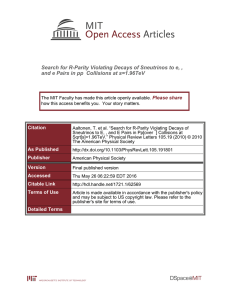
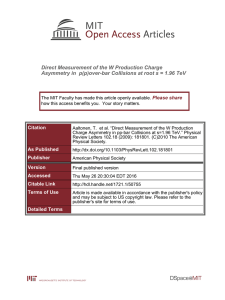
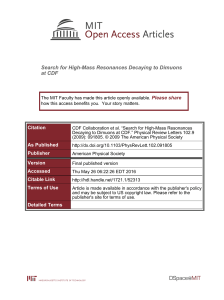
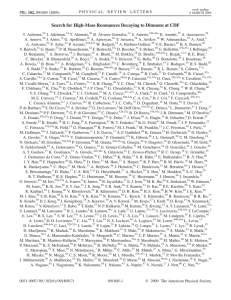
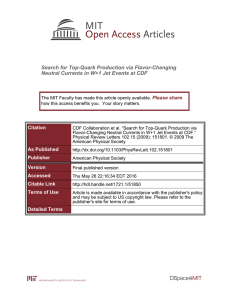
![Observation of Exclusive Charmonium Production and sqrt[s]=1.96 TeV](http://s2.studylib.net/store/data/012099626_1-e3cc2d249a0b30b56e2a5d794873df6b-300x300.png)
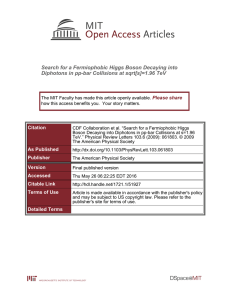
![Observation of B[0 over s] [bar over D][superscript 0]K[0](http://s2.studylib.net/store/data/011609251_1-a22ce5a4126015e69fdddbd84fc29f1f-300x300.png)
